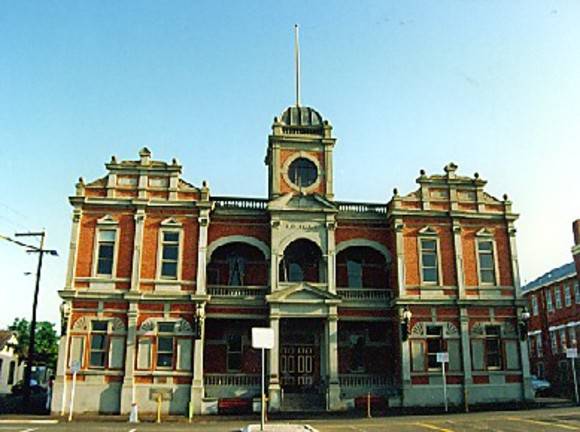| Back to search results » | Back to search page » |
|
Town Hall - Castlemaine Historic Area
Location25 Lyttleton Street,, CASTLEMAINE VIC 3450 - Property No B5255
File NumberB5255LevelLocal |
|
Statement of Significance
The Castlemaine Town Hall was designed by Wilkinson and Permewan, as the successful applicants for a competition held in 1898. the foundation stone was laid on 24/08/1998 and the building was executed by H D McBean at a cost of 2,000 pounds. McBean was the builder of many substantial buildings in Castlemaine, including part of the hospital and Thompson's foundry.
The building was constructed of face red brick and coloured cement dressings (now painted white) and a tiled roof. it is essentially a Queen Anne building, employing elements of Dutch Renaissance, but indicative of the eclecticism of the period. pavilion-planned, the projecting wings are marked by gabled of Flemish inspiration and by the verticality of the windows and the superimposed trabeated system of Tuscan and composite orders. An unusual feature of these wings is the panelling and representation of fans to the side of the lower windows.
The central vertical element is composed of two storeys of pedimented porticos stacked in top of each other with the upper pediment having broken top chords.
The vertical line is continued beyond the balconied parapet by a square tower with circular openings on all four sides and topped with an onion dome. The spaces between the wings and the central tower are filled with three-pointed arches, a device used in many later public buildings.
The design was repeated, almost exactly by the same architects in the design of the Eaglehawk Town Hall in 1901.
Adopted from Heritage Victoria Statement: 17/09/2012
Classified: 20/02/1984
Part of Castlemaine Historic Area B4894
Castlemaine grew as a result of the discovery of gold along Forest Creek in July, 1851. By December of that year the population on the field was greater than that of Melbourne. In 1852 Mr Templeton surveyed the township of Castlemaine and in 1853 the first auction of the town site was held.
The Castlemaine goldfield was allegedly the richest alluvial goldfield in the world. Such was the prosperity of the diggers that the townsfolk were optimistically expectant of Castlemaine becoming Victoria's second city. The prosperity of the diggers and the optimistic townsfolk is reflected in the high number of imposing buildings erected in the first few years of the town's life. However, the rich alluvial diggings were worked out within 15-20 years. From the 1870's the town's population began to drift away, but they left behind a rich legacy of the town's former prosperity in the form of its buildings.
Within the Castlemaine Historic Area may be found many items of significance. These range from intact nineteenth century streetscapes composed of imposing public buildings to simple miner's cottages. Within the historic area there are a number of identifiable component areas, each telling an important part of the history of Castlemaine. In addition, there are many other items of significance outside of these areas, but still within the historic area. These include the former steam flourmill, the Church of England, the Congregational Church and Forest and Barkers Creeks.
Despite the town's topographical confinements to the valley of the two creeks, the wide streets and large buildings convey an atmosphere of grand spaciousness in this central Victorian goldfields town.
Historic Area Classified: 01/12/1982
Group
Community Facilities
Category
Hall Town Hall




